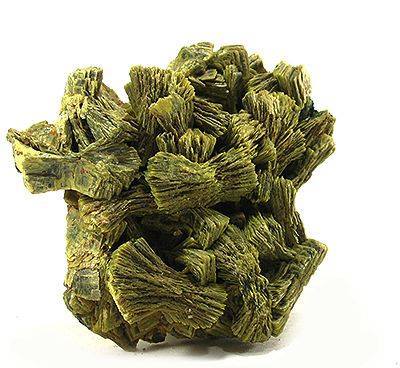Hot rocksResembling a pile of wheat sheaves or moss growing on a rock, the thin plates of the radioa
Hot rocksResembling a pile of wheat sheaves or moss growing on a rock, the thin plates of the radioactive mineral Autunite have grown in the oxidised zone of a uranium deposit, whether in the granite that distilled it from the Earth or precipitated by uranium bearing fluids in a vein. This element’s minerals are often very pretty (seehttp://tinyurl.com/nqtc59a for an example), and loved by collectors, but need special storage and handling.Autunite (a hydrated uranium phosphate) is named after the French district in which the type locality was discovered in 1852. It is the most commonly collected radioactive mineral, also fluoresces beautifully in UV light, and usually occurs as books of tabular crystals. As it dehydrates, it converts to other minerals, so museums cover it in lacquer to preserve its integrity.This mineral is radioactive, and special storage in a labelled, lead lined, air tight container away from inhabited zones of the house (eg attic) is recommended, and limited handling advised. One should open the container in an outside space to allow radon to escape, thoroughly wash after handling, and avoid drinking or eating nearby while it is out. Since it is fragile it forms dust very easily, so bear this in mind. It should also be stored away from other minerals as its radiation may affect their colour.It occurs in the granites of Cornwall in England (source of the Greek name for Britain, the Cassiterides due to the tin ore for Bronze mined out of the same granites), the USA and the Democratic republic of Congo. The specimen in the photo measures 9.5x9.1x2cm.LozImage credit: Joe Budd/Rob Lavinsky/iRocks.comhttp://www.mindat.org/min-433.htmlhttp://www.galleries.com/Autunitehttp://www.gothotrocks.com/pages/safety.htm -- source link
Tumblr Blog : the-earth-story.com
#mineral#minerals#uranium#autunite#science#geology#granite#phosphate#phosphorus#radioactive#mineralogy
